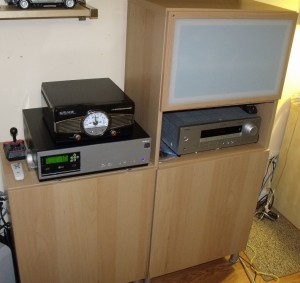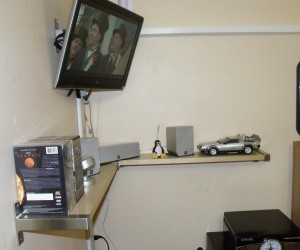 As the third part, and for now, the final part, of our multipart series, Better Know a MythTV configuration, we profile the second of our MythTV frontends. This frontend is the older of the two, and is hooked into some home theater equipment for a more immersive experience.
As the third part, and for now, the final part, of our multipart series, Better Know a MythTV configuration, we profile the second of our MythTV frontends. This frontend is the older of the two, and is hooked into some home theater equipment for a more immersive experience.
Now, with all of these systems, bear in mind they’ve been designed, redesigned, expanded, etc. But we are, by no means wealthy over here. Some concessions have been made, and parts upgraded and replaced as financial and practical considerations demand it.
The current system was built when HDMI was still at the upper end of hobbyist grade. Now, many computer monitors and amplifiers include HDMI switching. This system was designed originally with component video in mind, at the cusp of our upgrade to HD programming. It is set up for expansion, and likely will be, piece by piece in the future.
As you can see, we’ve continued our modular Ikea furniture theme from the other setup. Originally we did have a more conventional audio rack here, but switched to these two separate pieces. The router, the Silicondust HDHomerun, and the modem are actually stored in the bottom of one of those cabinets, and the glass door hides a tape deck and could hide additional equipment. An IR remote control would actually work through that glass.
Both rooms where you see the frontend setup were designed as possible backend locations. The whole goal of a redesign we implemented over the last two years was to allow us to rearrange the equipment in a variety of ways depending on changing need. For example, we moved a file cart to the right of the setup to show the wire hookups for relocating the backend if needed.
The receiver is located on the right, and is an inexpensive Yamaha that incorporated all the features we wanted at the time. On top of the frontend you can see what looks like an old style radio. It is that and a record player. It adds to the character of the room, in our opinion.
Then we finally get to the frontend itself. The case seen is long since discontinued. The closest current model is the Antec Fusion NSK2480, which is a newer version of what we actually have. Like all of the others, this system also has an Asus motherboard. There is another CrystalFontz 635 LCD panel in this system, this one in Green. We prefer the blue, which is why we got it for the second panel.
 The processor is an AMD Athlon(tm) 64 X2 Dual Core Processor 4200+, which was retired from the backend during a previous upgrade. Both frontends have 2GB of RAM. RAM is fairly cheap nowadays anyway. The remote is an RF Snapstream Firefly.
The processor is an AMD Athlon(tm) 64 X2 Dual Core Processor 4200+, which was retired from the backend during a previous upgrade. Both frontends have 2GB of RAM. RAM is fairly cheap nowadays anyway. The remote is an RF Snapstream Firefly.
The screen here is a 23″ Westinghouse LCD with DVI and Component inputs and a maximum resolution of 1600×1200, mounted on a swing arm. This is one of the pieces we are hoping to expand soon into a larger, higher resolution with HDMI inputs, which will certainly, if nothing else, allow a thinner cable down to the computer.
You can see under the monitor the Left, Right, and Center channel speakers, the right speaker nestled in between Tux the Linux Mascot and the Time Machine, which we recently bought on a whim. The configuration of the room, a long rectangle, is not 100% conducive to a home theater design. To the left of the image is a window, and thus the positioning of the monitor and speakers is the only way to make sure viewing isn’t on top of the monitor, and that optimal viewing and sound is accomplished from either the couch, placed on a long wall, or a chair placed in the center of the speakers.
The rear speakers are not pictured, but are placed in the traditional isosceles trapezoid configuration, oriented according to the limitations of the space, again planned to surround primarily a person seated in a chair in the middle of the room. Under the shelf that holds all the speakers pictured is a through-the-wall air conditioner, which is why the units that hold the equipment are not placed against it. As mentioned, some of the decisions were made due to the configuration of the room. If anyone thinks they might have a better idea, please suggest it, as we’ve yet to figure out a superior layout.
So, that is it for now. We certainly have expansion hopes for the future, including to migrate to a monitor with an HDMI input, and possibly the receiver as well. Someday we’d like to try an Atom-based frontend, for the size of it.
Hopefully, you’ve gotten some ideas for systems of your own. What we’ve learned over the years is to build simply, but build room for expansion and redundancy. Any questions?
Related articles by Zemanta
- MythTV Rig: Part 2 – A Frontend (gadgetwisdom.com)
- MythTV Rig: Part 1 – The Backend (gadgetwisdom.com)


Blogging…: MythTV Rig: Part 3 – The Home Theater Frontend http://bit.ly/8ZWZoB
This comment was originally posted on Twitter